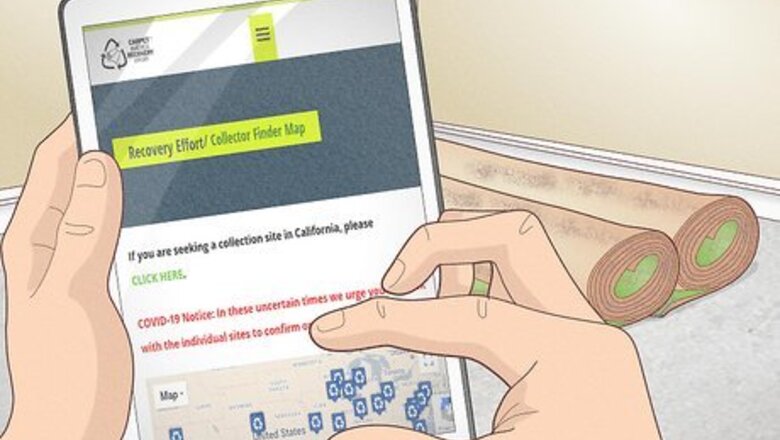
views
- Roll up and tape strips of old carpet. Throw small amounts in your usual trash can or dumpster, or schedule a bulk trash pickup for large amounts.
- To avoid landfills, donate or sell your old carpet if it’s in good condition. Contact CARE to locate carpet recycling facilities near you.
- For a hands-off approach, hire a junk hauling company to pick up your old carpet or ask your new floor installer to remove and dispose of it for you.
Getting Rid of Old Carpet
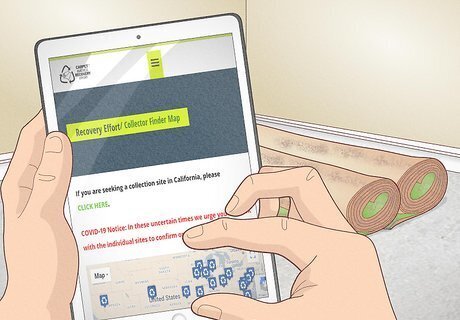
Contact CARE or local carpet vendors for carpet recycling. Visit the Carpet America Recovery Effort’s (CARE) website to find facilities near you that recycle old carpets and padding. If there’s one, call them to discuss the amount and type of carpet you have and see if they’ll take your carpet. If the recycling facility can’t take your carpet, reach out to local carpet retailers or manufacturers. They may be willing and capable of recycling as well. Carpet padding is easier to recycle since it’s only made of foam. Carpet is more complex but can be turned into plastic pellets and other materials. It usually costs about 5 to 25 cents per pound (0.45 kg) of carpet to recycle. Carpet does not break down in landfills. In the US alone, Americans dispose of 5 billion pounds (2.3 billion kg) of carpet per year.
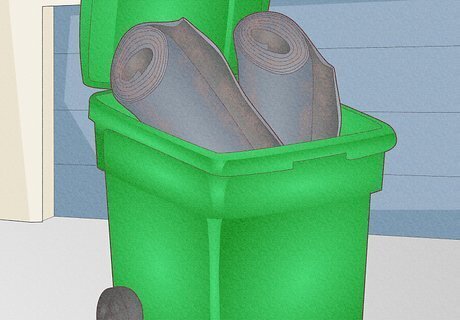
Throw small amounts of rolled carpet in a trash can or dumpster. If you’re only ripping up a hallway or a staircase, for example, roll your carpet strips into tubes, tape them, and place them in a heavy-duty trash bag. Throw the bag in or next to your usual trash can or dumpster. Be careful of stray nails or staples while you handle old carpet. Consider wearing protective gloves to be safe. Carpet can be thrown in a dumpster unless your town’s guidelines say otherwise.
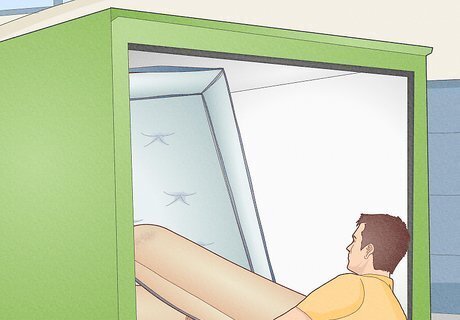
Wait for or schedule a bulk trash pickup for large amounts of carpet. If the amount of carpet can’t fit in your usual trash container, look up when your town does bulk pickups or call public works to schedule one. Make sure your carpet is rolled and tied before pickup to ensure it doesn’t get left on your curb. Clarify where to leave your carpet for pickup. It may be in a different place than your regular trash can. Bulk pickup processes are different from town to town. Double check your community’s procedure to make sure all of your carpet can be taken.

Drive your carpet to a designated waste facility or dump. When your town’s garbage service can’t take your carpet, contact waste facilities nearby to coordinate a drop off. Inquire about fees for dumping bulky items—it may be a flat rate or based on weight. Use or rent a truck that can fit all of your rolled-up carpet to save you multiple trips. Always call ahead to make sure the facility accepts carpet before making the trip. Some municipality dumps offer a small number of free trips per year.
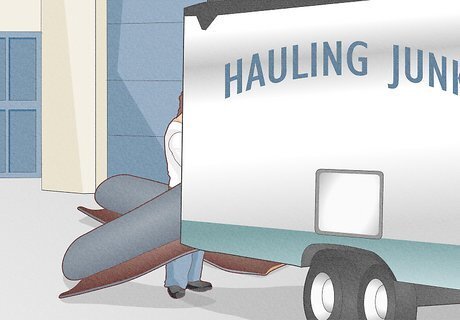
Hire a junk removal company to haul your old carpet away. Contact reputable junk haulers like 1-800-Junk-USA or College HUNKS Hauling Junk and schedule a pickup. They typically use trucks fitted with dumpsters to carry your waste and will dispose of it in the most eco-friendly way possible. Choose this option if you don’t want to rent a truck and your town’s garbage service won’t accept your carpet. Make sure the carpet is rolled and bagged before the junk haulers arrive. Prices usually range from $100 for small junk piles to $600 for a full truck-load of waste. Haulers recycle or donate whatever they can before sending the rest to a landfill. Research your junk haulers to see their environmental policies.

Rent a renovation dumpster if you’ve got lots of carpet and other junk. Call a junk hauling or dumpster rental company like Bin There Done That for rental and delivery. They typically rent by the week, which gives you lots of time to load it up if you’re doing a major renovation or project. When you’re finished, they’ll pick up the dumpster and dispose of what’s inside for you. Clarify what can and can’t go in the dumpster along with carpet. Some companies won’t allow concrete or certain substances, for example. Ask about extended rental and weight limit fees, since these can increase the overall price. Rental rates vary by dumpster size. Small ones range from $100 to $350 per week, but very large ones can be up to $850 per week.
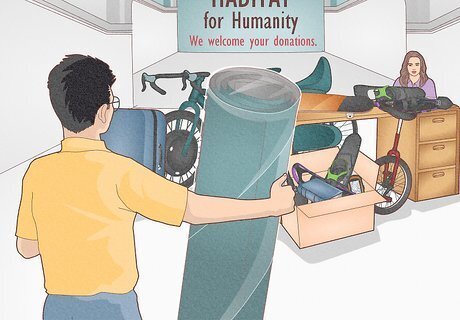
Donate clean carpeting in good condition or unused carpeting. Contact national charities like Habitat for Humanity or local organizations that accept carpet donations. Make sure your carpet is clean, usable, and not worn out or infested to increase your chance of acceptance (many organizations refuse used carpet for health reasons). New or unused carpet is more likely to be accepted. Donated carpets are usually refurbished and given to those in need of new flooring, like after a fire or a flood. Ask for a receipt with the charity organization’s name if you want to deduct the donation on your taxes.
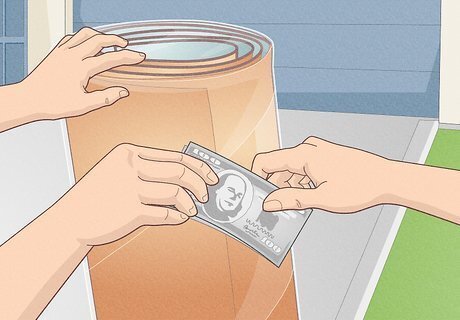
Sell your carpet to thrift shops or individuals. If your used carpet is in good, clean condition, contact local thrift shops or second hand furniture stores to see if they’ll purchase it from you. Try uploading photos to a site like eBay, Craigslist, or Facebook Marketplace to sell your carpet online to individuals, too. Make sure your carpet is clean and in the biggest pieces possible to increase your chances of selling it successfully.
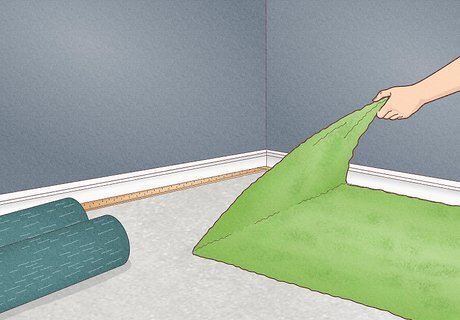
Have a new carpet installer remove and dispose of carpet for you. If you’re replacing your carpet, inquire about removal and disposal. Many companies offer this as part of the purchase price or for an additional fee, meaning all you have to do is move your furniture out of the way (and some companies will even do that for you, too!). Always clarify exactly what you’re getting with your salesperson. Ask if removal and disposal are part of the installation fee or an additional charge. Remember, removal and disposal are not the same thing. Make sure your installer will take the old carpet with them after the new one is layed down. Removal and disposal typically costs about $1 or $1.50 per square foot (0.3 m) of carpet.
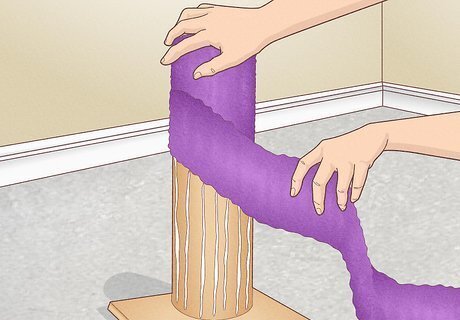
Repurpose or reuse pieces of old carpet around your house. If your carpet is in decent shape, cut it into small pieces for home improvement projects. You likely won’t be able to repurpose all of your carpet, but this is a creative way to reduce disposal costs and keep it out of a landfill. Consider some of these ideas: Put small pieces on the legs of furniture so they don’t scratch your floors. If you have a cat, make them a scratching post. Cut custom disposable car mats or place strips of carpet on your garage walls to protect your car doors when you open them. Keep a strip in your car trunk to use for tire traction on snowy days. Put strips on ladder rungs for better traction.
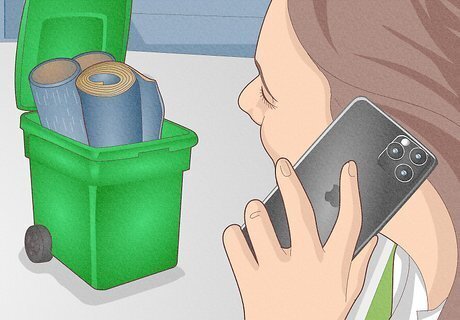
Check your local guidelines for disposal rules and recommendations. Call or visit your local municipal recycling coordinator or department of public works’ website. They’ll explain the rules around where and how much carpet can be thrown away in municipal dumpsters or picked up from your house on garbage day. Ask about carpet recycling programs in or near your town, too. Carpet might be considered bulky waste in some towns or municipal solid waste in others, which affects how your community handles disposal. Guidelines for carpet may be different from town to town, so reach out to clarify before you settle on a disposal plan.
Removing Carpet Yourself
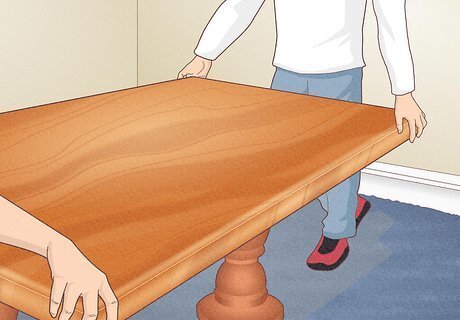
Clear the room of furniture and other obstacles. First, move all furniture and freestanding decor out of the room you’re ripping up. If your carpet was installed under a shoe molding, use a crowbar to pry up the molding. Also remove any doors that swing into the room, including bi-fold doors. Shoe molding is the thin strip of molding that hides gaps between the flooring and baseboards.
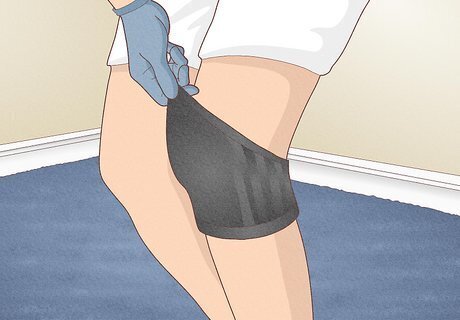
Put on a dust mask, protective gloves, and knee pads. Carpet (especially old carpet) is full of dust, so wear a mask to keep from inhaling loose particles. There are a variety of nails and staples holding it in place, so wear thick gloves to protect your hands and fingers. Put on knee pads to protect your knees from nails and staples (and for general comfort since you’ll be on your knees a lot while you rip up the carpet).
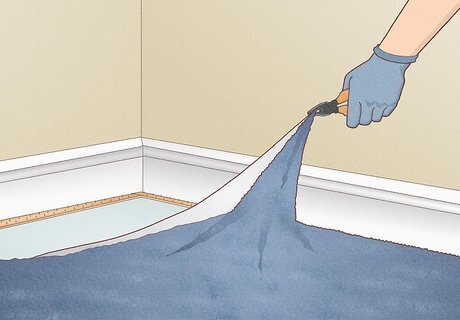
Pull the carpet away from the tack strips along each wall. Start in a corner and grab the carpet with pliers. If it pulls up easily, grab the carpet and keep pulling it off the tacks by hand. Pull the carpet free from every wall all the way around the room, folding it the edges toward the center of the room as you go. If it won’t lift easily, cut a 6 in (15 cm) square with a utility knife in a corner of the room. Lift out the square piece and then pull the carpet by hand.

Cut the carpet into manageable strips with your utility knife and remove. Pick an edge and fold 3-4 feet (0.9-1.2 m) of the carpet over. Cut the carpet along the fold from the back (it’s easier than cutting through the front). Roll up the freshly cut strip and tie it with heavy-duty string or duct tape, then continue cutting strips in the same way all across the room. If there’s a closet, cut the carpet at the carpet door. Pull up and roll the closet carpet separately. Leave metal transitions between carpet and other flooring alone. Remove the carpet rolls from the room when you’re finished.
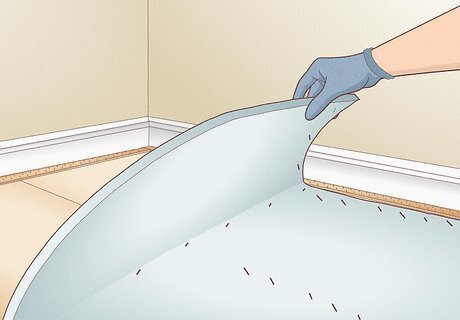
Remove the carpet pad in the same way you removed the carpet. Start pulling up the padding in a corner and yank it free from all the tack strips. Fold and cut the padding into strips and roll them up for disposal. If the padding is glued down to the subfloor and large chunks are sticking, use a sharp-bladed floor scraper to lift the chunks away. Use the scraper to remove any staples holding the pad down if the subfloor is made of plywood or particle board. If the subfloor is hardwood that you want to preserve, use vise-grip pliers or a small, flat-blade screwdriver to carefully pull up the staples. Use a scraper to remove carpet glue from the subfloor. Pour boiling water on stubborn glue to loosen it, then scrape it after 10 minutes.
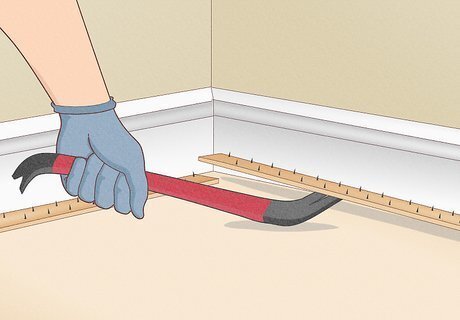
Remove tack strips if they’re damaged or you’re not re-installing carpet. Just pop them off the floor with a pry bar—carpet installers can put new ones on if you eventually want carpet again. Make sure all tack strips are gone from the room if you’re putting in wood, tile, or laminate flooring next. If you’re putting in new carpet and the tack strips are in good shape, leave them where they are.
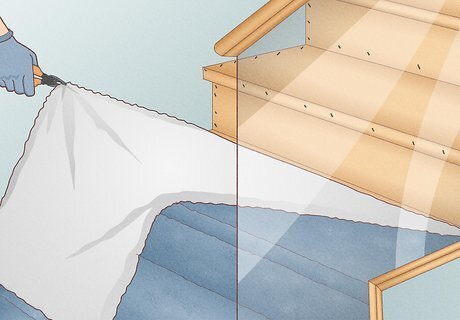
Rip carpet off of stairs in one piece. Use pliers to grab a corner of carpet at the top of the stairs and pull it free. Grab the loose carpet with your hands and use quick yanking motions to pull it loose from all the stairs. Roll up the carpet and then remove any padding, tack strips, or staples as needed. If any carpet fibers got stuck to painted baseboards, use a putty knife to scrape them free before yanking the carpet up to avoid damaging the paint job.
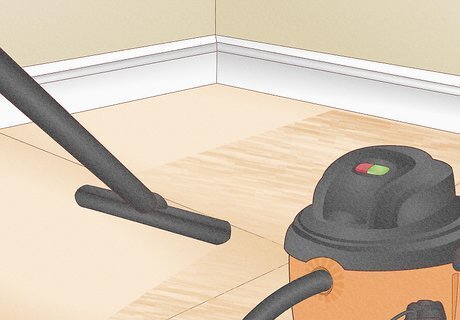
Clean up the subfloor with a shop-vac and a mop. Once all carpet, padding, tack strips, and staples are out of the way, go over the subfloor with a shop-vac to pick up solid debris, then mop the floor. This way, installation will go faster and you won’t have any dirt or debris underneath your clean new flooring. Make sure your subfloor is clean and fully dry before installing new carpet.
















Comments
0 comment